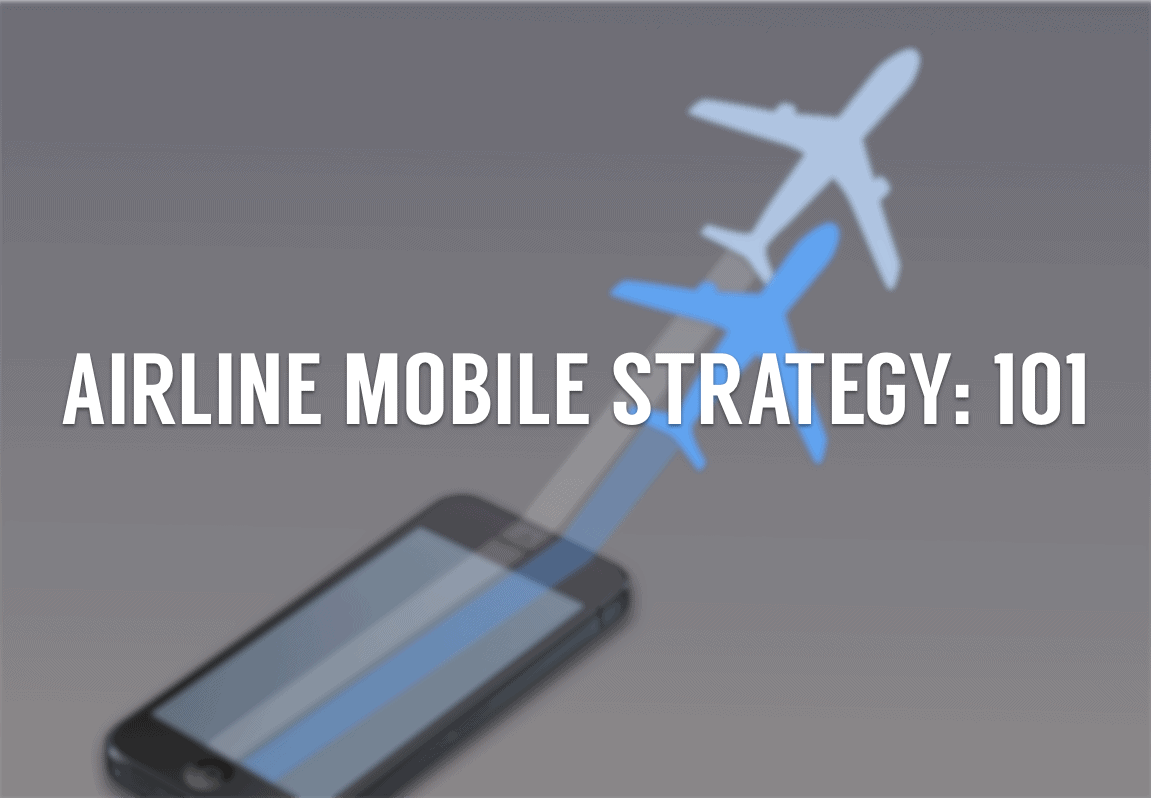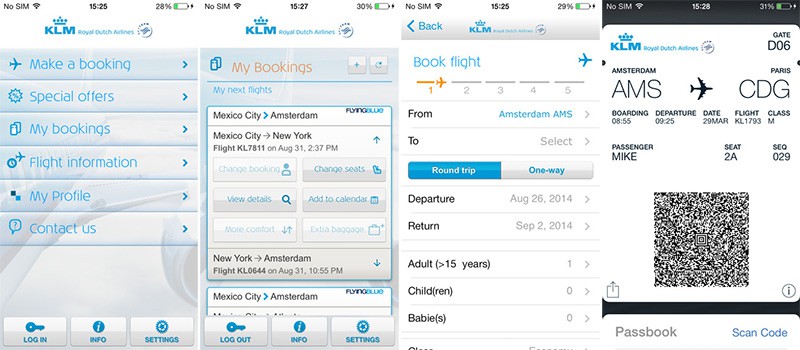EveryMundo is frequently approached by airlines to help construct “a mobile strategy.” The immediate flaw in that request is the assumption that an airline only needs one strategy to address the volume and diversity of mobile users. Mobile customers can be placed into four general buckets, and any comprehensive airline strategy for mobile must address the specific requirements of each group. At a minimum, recognizing the distinct needs and strategies for these different groups will allow airlines to effectively allocate resources and budgets.
| Research Traffic | Transactional Traffic | Phone Orders | Post-Transaction Traffic |
|
|
|
|
| Mobile Strategy Focus on Messaging. Allow Customer to email Flight Selection and book on Different Device. |
Mobile Strategy Optimize Booking Funnel, improve Site Speed and track all Conversions. |
Mobile Strategy Provide Call Center number as Additional Point of Contact |
Mobile Strategy Provide “Manage Booking” feature on App and develop mobile SEO to answer post-transactional questions. |
Mobile strategy needs to be adjusted depending on the customer needs
Mobile Web Infrastructure is a Prerequisite
Before even considering mobile user types and acquisition strategies, airlines need to have the appropriate infrastructure. It may seem obvious, but it is surprising how many airlines do not have a mobile optimized site. Mobile optimization may refer to site design, site structure, page speed, content and all those features that keep mobile visitors on the site—hopefully long enough to execute a flight booking.
It is best practice to use a responsive site design* but search engines also support dynamic serving or separate site configuration, if set up correctly. Having appropriate mobile web infrastructure will not only improve conversion, but will help your airline to rank in organic search results for mobile and improve quality score in paid search.
It is also important to note that a mobile site is not an alternative to an app. They both serve unique functions for different user categories. The customer who has already downloaded and is using your airline’s mobile app has different requirements and considerations than one who is finding your site through a non-branded search query, for example.
*Responsive design and the relative benefits of various strategies for achieving mobile site optimization are beyond the scope of this particular article, but we promise we will address these issues fully in another post
1. Research Traffic
Those mobile users who are not yet ready to book a flight but are browsing deals and destinations in preparation for a future flight should be treated distinctly from other types of mobile users. In contrast to other user categories, this group will likely execute a transaction at a later date and, frequently, on a different device.
Messaging
Whether you are targeting these top-of-the-funnel users using display advertising, social media channels or even through paid search (we recommend airlines allocate most of their paid search resources on transactional traffic), your airline should be focused on destination oriented messaging. These users are still deciding if and where they want to travel, so special offers and content around top destinations will be effective at drawing them in.
For mobile app users, be sure to regularly push deals and destination based content to stimulate their thinking about upcoming travel plans.
Landing Pages
When research traffic makes it to your (hopefully) mobile optimized landing page, they are not quite ready to book yet so your airline’s landing page should make it easy to save a particular itinerary or deal, either by emailing, bookmarking or other tactic. When the mobile user is ready to book, he or she can easily come back and do so.
Tracking
Because this user category is likely to return later, via a different channel or device, more advanced tracking and analytics will be useful to understand the efficacy and impact of your various campaigns. Multi-touch attribution models and cross-device tracking – big and important topics on their own – will be core to establishing a sustainable, high-impact strategy targeting this type of mobile user.
2. Transactional Traffic
Although a majority of flight bookings still happen on desktop, an increasing share of mobile users are comfortable transacting via their mobile device. Acquiring and converting these potential customers has an immediate and direct impact on the bottom line.
Mobile Search
Your mobile optimized site is a first step toward mobile SEO, which will be a more complex undertaking, but here are a few SEM tips for mobile that can help you unleash some instant offense driving mobile transactions:
- Adjust character length of ad copy and ad extensions to be appropriate for mobile search ads
- Focus on shorter tail origin and destination based keywords (“flights paris london”) for non-brand search, because mobile users are unlikely to type in longer keyword phrases on their phones (“cheap flights from paris to london”)
- Make sure you are appearing in the first or second position for mobile searches on top-converting routes—otherwise, you’re probably not appearing at all
- Pre-populate the flight search panel with O&D information on landing pages to limit the number of steps a mobile user must make to initiate a booking
- Use remarketing lists to apply bid modifiers in order to more effectively funnel budget into mobile search
A more comprehensive discussion of best practices for mobile SEM for airlines will be coming soon in which we will dive into the details of all these points (and more).
Mobile App
For those brand loyal travelers who are using your app, you will want to make it as easy as possible for them to execute a flight booking. You can leverage all of the information you already have about them to make this process easier:
- Prepopulate the search panel with their home airport
- If possible, keep all of their personal and payment information on file so that they don’t need to input it again
- Make the “Book Now!” button very prominent (seriously)
Tracking
Tracking is relatively simple here. We recommend evaluating the effectiveness of these campaigns on a last-click basis, optimizing to a reasonable cost of sale or ROAS. Just be sure you have run a number of test transactions to ensure these channels are tracking revenue and transactions accurately.
3. Phone Orders
Customers who have difficulties booking on mobile or feel more comfortable speaking with an airline representative prefer to call the airline directly to make a flight purchase. Google offers call extensions to capture this type of customers:
Call Extensions
Mobile Call Extensions in Google AdWords refer to a clickable call button displayed with the ad on smartphones. Airlines need to keep in mind that call extensions in ads should only serve as additional point of contact for flight bookers because clicks on call extensions are paid. Airlines can avoid paying for complaint calls, technical questions, or management of bookings calls by expanding negative keywords and optimizing ad copy.
Tracking
All marketing activities need to be tracked, which is somewhat more complicated for web-to-call transactions than pure eCommerce. However, best practices to track calls that originate from a paid search ad include the following:
- Google Forwarding Number: Australia, France, Germany, Spain, Sweden, the UK, and the US
- Set Up Call Conversion Tracking in AdWords: Count calls longer than a determined time period (e.g. 180s) as a qualified lead
- Dedicated Phone Number for other markets
- Use of local numbers in each market to not discourage people from completing a call in order to avoid charges for international numbers
- Website Call Conversion Tracking to measure calls from your website that occur after an ad click.
- Feedback from the call center to assess reasons for calling and general call quality
Call Extensions are usually not a major mobile strategy for airlines a number of reasons. First, the volume of customers who are willing to book over the phone compared to website traffic is relatively small. Additionally, advertising the phone calls can lead to paying for unqualified traffic, complaints and the like. And, finally, it can difficult to accurately track call conversions back to a specific campaign or keyword, which hinders optimization.
4. Post-Transaction Traffic
Customers who have already completed a flight purchase use mobile sites and apps to manage their booking or to review their flight experience. This is more about customer service and retention than about acquisition and conversion, which is EveryMundo’s core competency, but we felt it was worth mentioning.
Mobile Apps
Mobile Apps offer the opportunity for users to conveniently manage their flight booking. Therefore, the flight confirmation page on the mobile site is an important location to promote your application. Any airline mobile app should provide a Manage Booking feature to address the following post-transactional needs:
- Seat Selection
- Check-in
- Mobile Boarding Pass
- Ancillaries
- Change Flight
- Flight Tracker
For example, the KLM mobile app offers useful features with users benefiting from services such as selecting seats, check-in for flights or purchasing extra baggage allowance:
A mobile app also offers the opportunity for additional app features, e.g. promo push, inspiration for other travel destinations, and flight bookings in the future.
Closing Thoughts
Airlines that fail to fully embrace mobile strategies will quickly find themselves falling behind. Mobile may not replace desktop traffic as the primary source of airline reservations this year or even next, but that time is coming. The latest mobile strategies and technologies across industries offer an increasing level of customer service and convenience that has not previously been available in the airline industry. The biggest and most competitive players in travel eCommerce, the OTAs and metasearch engines, have already fully leapt into the world of mobile acquisition and conversion, and airlines worldwide need to follow suit in order to protect and grow their direct acquisition channels in this increasingly competitive arena.
By: [post_authors_post_link]



